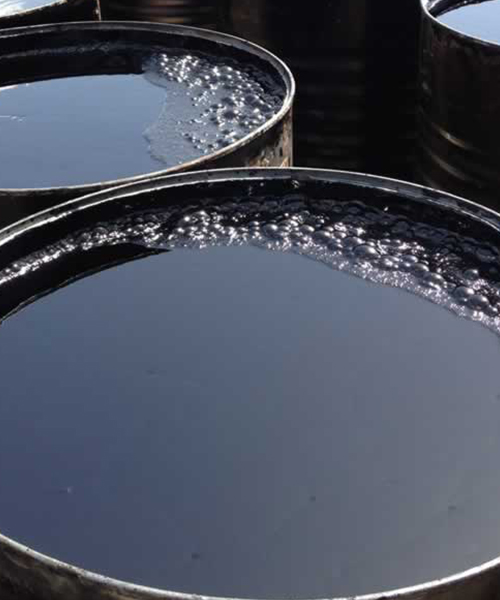
They consists of dispersions of minute droplets of bitumen in water.
The bitumen content can be varied as per requirements. They are and typically between 35% and 65%.
The primary objective of emulsifying bitumen is to obtain a product that can be used without the heating normally required.
The coating of the bitumen particles by the emulsifier gives them an electrostatic charge. Depending on the type of emulsifier, this can generally be either negative or positive. Emulsions in which the bitumen droplets are negatively charged are called anionic emulsions. Emulsions in which the particles are positively charged are called cationic emulsions. Cationic Emulsions are mainly used for the Road sector while Anionic Emulsions are used for Water proofing in India. The main grades of Cationic Emulsions are Slow setting, Medium setting and Rapid Setting.
This high quality material makes it possible to fill potholes or carry out patch repair with open graded cold remix made on-site. The methods typically used for the repair of potholes using asphalt emulsions are throw-and-roll and full-depth removal and replacement. All these methods involve placing cold mix in the pothole with a shovel and compacting it with a truck tire, vibratory plate compactor or steel wheeled rolled.
| Residue on 600 microns US sieve% by mass | Max 0.05% |
| Viscosity @ 50˚ C (Saybolt), sec | 50-300 |
| Storage stability after 24 hours, & max | 1 |
| Binder – Residue by evaporation % min | 65% |
| Setting time | 30 Minutes |
Tack coat application is a light spray of Bitumen Emulsion, which may hand or machine sprayed. It is used to ensure a good bond between an old and new bituminous surfacing layer. It is normally applied very thin and evenly over the entire surface.
| Residue on 600 microns US sieve% by mass | Max 0.05% |
| Viscosity @ 50˚ C (Saybolt), sec | 20-100 |
| Storage stability after 24 hours, & max | 2 |
| Binder – Residue by evaporation % min | 60% |
| Setting time | 20 to 50 Mins |
It consists of application in one or two coats, each consisting of a layer of bituminous binder sprayed on a previously prepared base, followed by a cover of stone chips rolled into form a wearing course. RS-2 type cationic Bitumen Emulsion is ideal for surface dressing on the shoulders and for protection of freshly laid vase course. Typical rate of application for two coat surface dressing as per (MORT&H) CLAUSE 510.2 IS 28-32KG/10SQ.M
| Residue on 600 microns US sieve% by mass | Max 0.05% |
| Viscosity @ 50˚ C (Saybolt), sec | 100-300 |
| Storage stability after 24 hours, & max | 1 |
| Binder – Residue by evaporation % min | 67% |
| Setting time | Nil |
This is an obsorptive surface material (like low to medium high porosity wet mix macadam or water bound macadam), designed to penetrate, plug the capillary voids in the surface, bond and stabilize the existing and to promote adhesion between it and the construction course that follows.
| Residue on 600 microns US sieve% by mass | Max 0.05% |
| Viscosity @ 50˚ C (Saybolt), sec | 20-100 |
| Storage stability after 24 hours, & max | 2 |
| Binder – Residue by evaporation % min | 50% |
| Setting time | Black in colour |
CRMB is a Crumb Rubber based Modified Bitumen produced by incorporating crumb rubber and other additives compatible with bitumen.
CRMB, which is Crumb Rubber Modified Bitumen, is prepared in a centrally located state-of-the-art plant equipped with special high shear mixing facility.
RMB is the ideal binder to overcome the concurrent problems of raveling, rutting, un-dulations, cracking, bleeding, shoving and pot-holing of bituminous pavement.
CRMB 50
CRMB 55
CRMB 60
Bituminous mix, prepared with CRMB has a higher stiffness modulus, enhanced fatigue life, better resistance to creep & higher indirect tensile strength and quite suitable as renewal course and overlay material on surface which are badly cracked and subjected to heavy traffic
| CHARACTERISTICS | GRADE | METHOD OF TEST | ||
|---|---|---|---|---|
| - | 50 | 55 | 60 | IS No. |
| Penetration at 25 Cm 0.1 mm,1 00 g , 5s | 70 | 60 | 50 | 1203 |
| Softening point (R&B), °C, Min | 50 | 55 | 60 | 1205 |
| Flash Point, COC, °C, Min | 220 | 220 | 220 | 1209 |
| Elastic recovery of half thread in ductilometer at 15°C, percent Min | 50 | 50 | 50 | Appen.1 of IRC:SP:53-2002/ ANNEX.A of IS 15462:2004 |
| Separation, difference in softening point (R&B), ° C, Max | 4 | 4 | 4 | Appen.1 of IRC:SP:53-2002/ ANNEX.B of IS 15462:2004 |
| Viscosity at 150°C, Poise | 1-3 | 2-6 | 3-9 | 1206(PART 2) |
| Thin film oven test and tests on residue | ||||
| Loss in mass, percent, Max | 1.0 | 1.0 | 1.0 | 9382 |
| Increase in softening point °C, Max | 7 | 6 | 5 | 1205 |
| Reduction in penetration at 25°C Max | 40 | 40 | 40 | 1203 |
| Elastic recovery of half thread at 25°C Min | 35 | 35 | 35 | Appen.1 of IRC:SP:53-2002 / ANNEX.A of IS 15462:2004 |